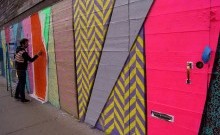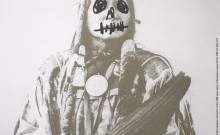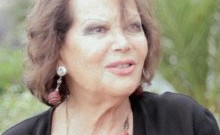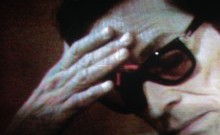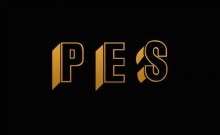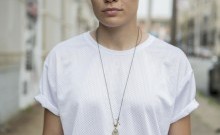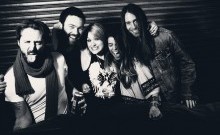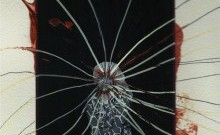Tom Koehler: Looking to See
Tom Koehler is a mystery.

sand bag detail from salad days, 2012
Let me explain : I've known Tom for a number of years. We met in Bushwick. He was lively & outspoken & called me on my obvious insecurities in a way that would have normally dispelled any reservation I may have had about sticking around to continue any introduction. But something about Tom's nature, suffice it to say, is so filled with a genuine grace & generosity that it intrigued me: there was an absence of malice even in his gentle ribbing, & even if he was going on & on about art & performance in a way that I didn't agree, at least he had something going on. It's no surprise he's known equally as Hood Gandhy as he is as Tom to his friends --- he has something more mystic than mystique in every way about him, though to say for sure exactly what would be in error. I still remember being stuck in LA last year, with no prospects for work, & getting a voicemail from Tom in NYC pretending to be some big 5 agent. It was the best thing I've ever heard, completely improvised, & I saved it for months, listening to it every now & again when jonesin' for a smile.
Koehler's work is like a seven car pile up of media & disciplines. He grafts found objects onto canvases filled with explosions of muted color, welds sharp edges to smooth surfaces, & imbues a caustic mixture of irreverence & humility in every piece he creates. Like Josef Beuys, his work defies characterizations. To say his work as a painter & sculptor is his passion would be doing a disservice towards the Artist's daily crucifixion: quite simply put, Koehler lives & breathes his artwork in a way that everything he does is an extension of his creativity. His apt / studio is indiscernible from his exhibit space, his personal effects indistinguishable from his creations. It is all the same thing to Tom : his wardrobe, his words, his affect & gregarious nature such that it implies a performance, a sense of the adorned & the ornamental in every satirical or absurdist gesture. We spoke over the course of a few days in September, while he prepared for a new installation for an upcoming show at Hood Gallery, which he founded last year & exists in an alley near Myrtle Ave & Harman St in Bushwick, beneath the M Train.
on TEXT/TEXTURES

separatism (mixed media on canvas 2014)

separatist (mixed media on linen 2014)

is the menace vs. everybody (oil & silkscreen on canvas, 2014)
EL: I like these newer pieces, with the word SEPARATIST, & SEPARATISM so featured. Can you talk about the way you utilize text in your work? There's a lot of examples here.
TK: Yeah. Well, I believe in blockades & barriers.
EL: Blockades & barriers?
TK: Building separation. I think everyone can feel that certain way. Just the way everyone keeps, besides the gypsy, you know, locking doors, close your fence. You believe in what you want to believe in.
EL: Do you mean physical borders or invisible barriers? Are they physical things, or something else, something interior?
TK: I think everything is representation. All art is representation, there's no abstraction. Abstraction doesn't exist.
EL: So it's not a literal thing?
TK: No, I think it's literal.
EL: So then do you feel everything is a direct representation, that everything is exactly as it looks, it represents just what you see? Or are you saying it can mean anything, even what it isn't?
TK: Well no, nothing's as it looks. I'm a big fan of direct line, though I have trouble doing it myself. Cause if something is too direct it makes me feel like I'm not putting enough energy into it. I use words because words are symbols that are already there.
EL: Is this a progression? In these different works I see all different types of text.
TK: Well the text is just something I'm striving to use. I use them in the same way that I would charcoal. I want the line there, and it just feels good to put it down. It's some sort of, it ends up feeling direct, like draftsmanship. I want people to think about it, but if they don't at least they end up maybe repeating the word in their head.
EL: You have stuff that's newspaper captioning, stuff that appears like a children's book illustration, & then stuff that's almost like the reappropriation of brands. Is this direction something that's more a continuation of one of these themes or a sort of confluence of all three?
TK: The words are really only there to be representational.

interior of artist's apartment
EL: Is it about stripping it all away till it's just one thing, from many ideas converged?
TK: It's just reaching, you know, trying to find a meaning, which is what all painters should do. It feels good to use text, & know that people are seeing exactly what you intend.
EL: Language is the one thing you know people will understand it, if they can read. Whereas the image confuses them.
TK: It makes it a lot like a still-life. But really I definitely try not to use it very often. I'm attracted to it, but it's just a desperate reach. I look for triggers. Language, picking apart language, it's something that's easily thrown around.
It’s important to interject here that I found my questions failing to ignite a discourse with Tom Koehler - someone who I've known for a couple of years now. The kid I'd known to be fearless & performative & lyrical in every sense of his speech & rhythms was gone the moment the question came to the nature of his life & work & the intertwined nature of the two. This was not the Tom I knew, or the conversation I had expected. I asked him if by giving an answer to any of these direct questions, he felt in some way that he might be losing something, that something would be taken from him irreparably. He wouldn't answer that either. Onwards…
on the look of DECAY

EL: You have some objects in your work that seem skeletal --- I'm referring specifically to the empty molds of the dead hives, the empty shell casings, the dead nails, the molds made from cigarette cartons. Everything appears to call attention to at least the notion of a discarded & somewhat brutal representation of things, in terms of the elements.

king (nylon on chrome steel, 2012)
TK: Well, you can draw all day long, but a drawing is never a painting. It's always kind of rough around the edges, but there's definitely influence from seeing images of wartorn countries, stuff like that. You have to thank god that you're able to exercise your freedom in such a pillow safe environment, you know? The trigger, that sort of reflection, that's really just about all you can do without being distasteful. It's not something people want to think about, the media doesn't really push it in our face, you have to do a little bit of digging to really see it. Not too much, but you do kind of have to really get out there, really go out, to see it: People are in wars, & we're just worried about our cellphones. Anyone can say what I just said & do what I'm about to do, so it's easily talked about. It's not in our face.
EL: So calling attention to people's garbage & things that are used…
TK: I mean, I got access to garbage, you know what I mean?
EL: (laughter) I think we all do Tom… It's interesting though that that's your reference for that kind of material imagery --- that it looks like war, all that waste. But waste is still what it is.
TK: It's just all an exploration for me.
EL: What is?
TK: Whatever you're doing, you're composing it.
EL: Your view of it? Your worldview?
TK: Well it's not the biggest stage… I'm exploring personally… Definitely not discovering the world, you usually just get stuck in your own little world really… And that's something I tend to harp on… We're definitely able to abuse our freedom here. We're able to be artists, & I think it's nice to be aware of that. I like to be aware of my place in it, & I feel guilty, so I'm trying to boil those feelings down, & sometimes things get lost because you get caught up in the feelings. We don't have to face the harsh realities.
EL: Right. It's just that your correlation is that by calling attention to people's waste & garbage is in some way a political statement. That sort of flies in the face of it being a direct representation, right? I mean if garbage is just garbage, then it doesn't mean anything else, it can't be making a point about the nature of waste & the ramifications thereof, right?
TK: Well I guess I'm saying that I don't see too much waste. I think found objects are still interesting, but I wouldn't call it that. Maybe it just all looks like garbage when I'm done with it. Nothing's ever… You're never really jumping up & down about your own work. It's all small accomplishments, & then you move on.
I felt like I didn't know why I was there. I felt like I didn't understand what was holding my friend back from explaining his work. And then it occurred to me --- for Koehler, to explain it would negate the act of creating the work in the first place. If it could be said out loud, or written down, exactly as he sees it, there would have been no need for him to lay his hand to the canvas in the first place.

everybody is the menace (oil on custom dress by lavemour design, 2014)
EL: So when did you start doing the gallery?
TK: Well about a year. I moved into it as a studio, & it seemed like it would be nice to give people an opportunity. People I know, artists who I think are doing things for people to see. The spot had a good vibe, and a nice layout, it was small. And I think people most of the time deserve to have a little platform to show. So I think it's kind of ending up as an ongoing installation, but people have their own sense of the spot, just like any other space. Like I said before, it's important for people to see the work because maybe then you could bypass the idea of owning something & just enjoy it, sit around long enough to feel it. Especially as an artist, it's easy to just stop in somewhere to check something out, especially if you've got something else to run off to. But to really stick around & vibe it out, just to stay a little bit longer, you're able to gain more from it.
EL: It is an inviting space.

detail of 10 soldiers, steel, sand & enamel. 2014
TK: Well I'm talking about anything though… Any situation, just give it a little bit longer a time, you can find something you like about anything… But viewing art in general, it takes a little bit longer than people are able to give attention wise these days… You got a gallery going, you just try to feed them long enough for them to stick around, & then it's up to them. I'd like to look back on it & know that people came & had a good time. That's important to me, & the work is the most important part of that. It's nothing new. But maybe to give it something that wasn't there, sometimes you don't have a room to fill up with your stuff & invite people to. So that was the point: to give people the vehicle. All that stuff's really important to me. I'd much rather be creating than curating.
EL: Do you feel like you wanted to move in that direction because of your own experiences with curation/being curated/trying to show your own work?
TK: It's always been independently shown stuff I've been involved with. If we weren't showing it in a garage, then I was renting out another empty studio space to show in. Like it or not, this is the Hood Gallery --- it is how it is. Giving the opportunity to let work breathe, & making sure everyone has a good time, that's the objective. But at the end of the day, I'm interested in when the Churches were patrons. That was a simpler idea: stuff being made for visual stimulation, & then taken away.
EL: It's sort of the same way the Art Establishment functions, the way the Church did. They control what's seen.
TK: No. You have control over what's seen. It's just about whether or not it's worth being seen. A lot of the time you're looking to own, you know? I think you should be looking to see.
EL: You think this is worth seeing?
TK: Sometimes. Yeah. You should probably see for yourself. Come on down.
I thanked Tom for the pictures & the conversation, bid him goodbye. He jumped up, eager to keep talking. It was then I realized he thought the recorder was turned off, finally.
TK: You know, I have a hard time talking about this stuff, because real artists live & die for their work. You know what I mean? I mean… The work should speak for itself. You gotta be scrupulous. Like your own worst enemy. And I just mean that there's a lot of things that are hard to talk about. Somebody else has probably already said it, maybe even better.
EL: Yeah, I know it's tough.
TK: I mean, you don't want to sound like the guy who broke out of the cave in the story, you know? Nobody cares what I say about the text. It's just there for you to decide. Nobody asks me what it means. Nobody asks that.
EL: What do you mean, the guy who broke out of the cave?
TK: The Allegory of The Cave, man: We're all just strapped in, trapped in the cave, watching the reflections & the shadows on the wall. And one day one dude busts out, & he sees the sky, he sees the Sun, the Moon, & the Stars… He goes back inside to tell everyone what he saw, & everyone's still strapped in, & they look at him like he's crazy.

detail of signature series (silkscreen & laser print on canvas, 2014)

detail of beat up & fake (mixed media on paper, 2014)

Hood Gallery is located in the alley between Harman & Himrod on Myrtle Ave, in Bushwick.









